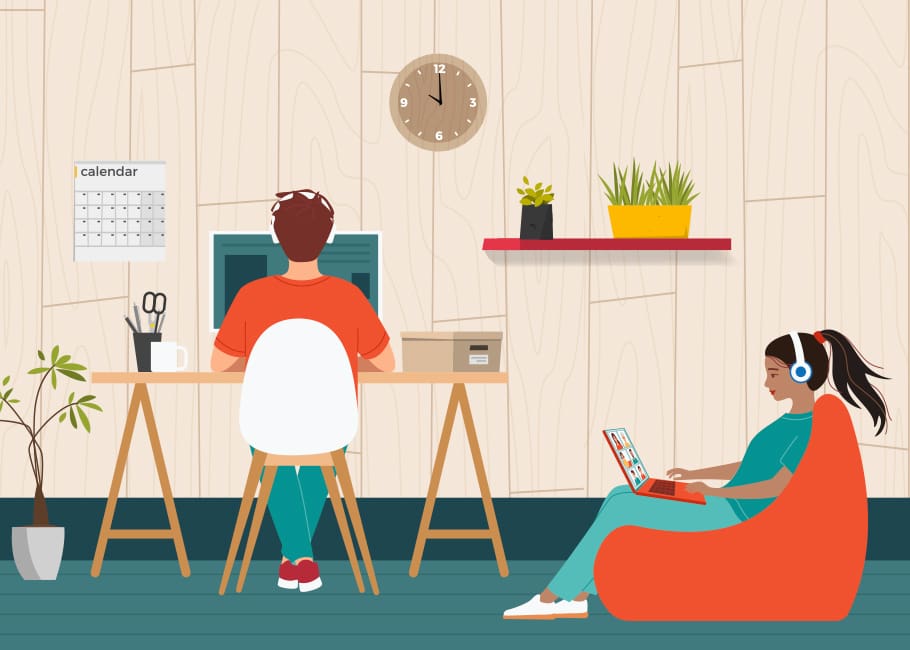Costco Connection | July | Special Section | Workspace for two

© Nadya Ustuzhantceva, drumcheg
Workspace for two
Tips to successfully share home office space with a partner
by ROSIE WOLF WILLIAMS
The last few years have changed the way we do business, and many brick-and-mortar businesses are making the change to fully remote or hybrid working. In fact, a recent study by tech communications company Owl Labs found 83% of survey participants who work from home say their productivity level is the same as or at higher levels than when they were working in the office.
If you are in this situation (or headed there), one partner in your home may already have an established office space, while the other does not. Or both partners may find themselves working from home for all or part of their employment. In both scenarios, couples will have to make adjustments.
Make a game plan
“One approach to solving the problem would be to set up clear boundaries and ground rules for the workspace,” says Dr. Alejandro Alva, founder and chief medical officer at Pacific Neuro-psychiatric Specialists in Orange County, California. He says this may involve discussing things such as storage space, noise level, work hours and/or other preferences. “It is important to communicate openly with your partner about any issues that may arise and work together to find a solution,” he adds. These might include designating certain times of day when each person can have the space to themselves, or alternating days if possible. It is also important to communicate openly about expectations, needs and concerns.
Professional organizer Phaedra Studt, owner of Practical Possibilities in Chicago, agrees. “I work from home when I’m not working with my clients in their homes,” she says. “Pre-pandemic, my husband worked primarily in the office.” She says that when he began working from home, she was initially frustrated because she went from having a quiet place to work, to having her work situation disrupted by countless phone calls that her husband would take. “I could sometimes relocate to another place of the home, but my desk had my second monitor and my scanner,” she adds.
The couple came up with solutions. Studt began using noise-canceling headphones with some music to help her focus. She also let her husband know the days that she would need the office and asked him to relocate for the day: “I started putting these days on the calendar so he [knew about them] before they came up.”
Practical matters
Studt suggests that a shared home office should have designated individual spaces. “Each person needs to maintain the organization of their own space when it comes to paper management,” she says. “Everyone has different styles for [organizing] their space and accessing their supplies. You will be able to keep the peace between you if you allow your partner to maintain their space however they deem fit—even if it’s less tidy than you would care for.”
Each partner needs an inbox for incoming household paperwork, according to Studt. She feels that, ideally, each person should have their own desk. If separate workspaces aren’t an option, she says, a surface that can hold a computer with some space to take handwritten notes will suffice. If this is the case, using laptops instead of desktop computers makes it easy for one person to relocate temporarily. Set up communal equipment, such as wireless printers and scanners, outside the office area where either person can access them without disturbing the other.
Alva says that communication is the most important factor in establishing home office spaces: “Make sure to communicate openly and honestly about your needs and expectations. Some possible examples might include asking your partner for their input on workspace design or usage, taking turns using the space or setting clear boundaries regarding noise level or work hours. It is also important to be open and honest about any concerns or issues you may be facing in order to find a solution together.”
Work-from-home tax impacts
The Tax Cut and Jobs Act of 2018 eliminated the home office deduction for W-2 employees. Self-employed persons operating a business from home are still entitled to a deduction if the office is used regularly and exclusively by the business owner. Once established as an in-home office, the room may not be used for other, nonbusiness purposes, says Costco member Jon Pryweller, managing director at Whitewater Group, a financial and tax service firm in Indianapolis.
That means if one partner is self-employed and has a home office, and the other partner is now working remotely for another company, sharing the home office, the self-employed person would lose the home office tax deduction.—RWW
Set boundaries
Don’t rely on assumptions or social norms to dictate your home office culture. Spell it out ahead of time: Are your papers off limits to your partner—no matter how messy your desk may get?
How do you manage interruptions, or interrupt in a courteous manner? One home worker puts on a headband with ears to warn her partner not to interrupt. Another hangs a “Do Not Disturb” sign on the door. Mutual respect is key.—RWW
Costco Connection: You’ll find a selection of office furniture, laptop and desktop computers, wireless printers/scanners, noise-canceling earbuds and a host of other supplies for your home office in Costco warehouses and at Costco.com.
Rosie Wolf Williams is a freelance writer based in Bennington, Vermont.



